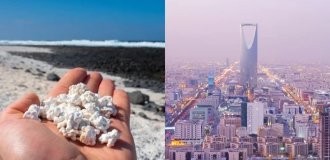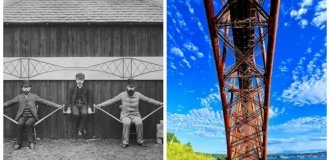Restoration of Peterhof after liberation and the end of the war (27 photos)
Recently, on the “chips” a lot of attention has been paid to Syria, namely architectural monuments. Then I remembered what kind of Peterhof our people received after the Nazis, and how courageously and painstakingly they restored it!
After the liberation of Peterhof, which was renamed Petrodvorets on January 27, 1944, restorers faced an unprecedented task - to revive the unique palace and park ensembles, and above all the 18th-century ensemble with its cascades and fountains.
On June 17, 1945, after demining the parks, clearing them of rubble, installing sculptures in their original places, and planting trees, the Lower Park was opened to the public. The most important milestone of the restoration was August 25, 1946. On this day, the first restored fountains of the central ensemble and water cannons of the Grand Cascade were solemnly turned on. On September 14, 1957, the Samson fountain began to flow again. For this fountain, sculptor V.L. Simonov recreated the stolen group “Samson Tearing the Lion’s Mouth.”
Five years later, instead of the ruins, the silhouette of the Grand Palace appeared over the Grand Cascade; four years later, gilded domes rose above the palace. In subsequent years, the restoration of cascades, fountains and the recreation of their sculptural decor continued. St. Petersburg sculptors revived more than four hundred sculptures for the fountain structures of Petrodvorets: monumental statues, bas-reliefs, vases and decorative details. Currently, there are 172 fountains and three cascades in the Upper Garden and Lower Park, for which fifteen monumental sculptures, dolphins, mascarons, garlands, brackets - over 330 decorative parts made of bronze and lead were recreated.
Significant progress has been made in the restoration of palace museums. In August 1952, the restored Hermitage Museum was opened for inspection. According to the project and under the leadership of V.M. Savkov and E.V. Kazanskaya, the Grand Palace was raised from the ruins. In May 1964, the doors to its first revived interiors were opened. According to the project of A.E. Gessen, the Monplaisir Palace was restored. The Great Orangery, the Aviary, the Marly Palace, where the restoration of the interior is being completed, as well as the Cottage Palace in Alexandria Park have become available for viewing.
In the revival of palaces and pavilions, the role of master restorers is extremely important. A particularly significant contribution was made by painters R.P. Sausen, L.A. Lyubimov, Ya.A. Kazakov, V.G. Korban, sculptors G.L. Mikhailova, E.P. Maslennikov, and model sculptors N.I. Ode , Mr. F. Tsygankov, carvers A. L. Kemnitz, B. K. Gershelman, N. E. Bazanov and many other wonderful masters - artists of various specialties.


Peterhof in tsarist times

1870

1912

1929

1940 Sea channel

1943 fascists in Peterhof



Peterhof after liberation. This is the legacy the Nazi invaders left for our citizens.






“The creative biography of Galina Leonidovna Mikhailova has been associated with Peterhof for more than thirty years,” the press service of the complex told RIA Novosti.
Galina Mikhailova began work in Peterhof with the restoration of the pediments of the southern and northern sides of the Grand Palace - “Fertility” and “Victory of Peter I over the Swedes”. She also carried out the restoration of the sculptural decoration of the White Dining Room, the Portrait and Throne Rooms, the Divan and Crown Rooms, the Partridge Living Room and the State Lady's Room.
Mikhailova’s most significant restoration work is considered to be the restoration of the grand staircase of the Grand Palace: she recreated two caryatids and three gilded wooden sculptures - allegorical images of the seasons - “Spring”, “Summer” and “Autumn”.
Mikhailova's last achievement was the restoration in 1986 of the Lion Cascade in the Lower Park of Peterhof. She managed to recreate the sculpture “Nymph Pouring Water” based on only a few amateur photographs that have survived to this day.
In addition to Peterhof, Galina Mikhailova worked as a sculptor-restorer in Oranienbaum, Tsarskoye Selo, as well as the Peter and Paul Fortress and the Summer Garden.

A large number of Leningrad residents and visitors from other districts and regions worked on the restoration of Peterhof.



1946 Restoration of the large cascade.

1946 Work on the Grand Cascade is almost completed.


1948

1954

Peterhof at the end of the last century. 1990s.























